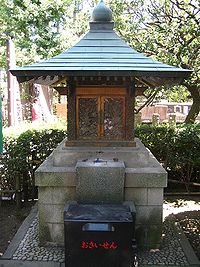
Kume no Heinai-do
Encyclopedia

Asakusa
is a district in Taitō, Tokyo, Japan, most famous for the Sensō-ji, a Buddhist temple dedicated to the bodhisattva Kannon. There are several other temples in Asakusa, as well as various festivals.- History :...
in Taitō, Tokyo
Taito, Tokyo
is one of the 23 special wards of Tokyo, Japan. In English, it calls itself Taito City.As of April 1, 2011, the ward has an estimated population of 168,909, with 94,908 households, and a population density of 16,745.86 persons per km². The total area is 10.08 km².-History:The ward was founded...
. The shrine houses a stone statue of Kume no Heinai, a samurai
Samurai
is the term for the military nobility of pre-industrial Japan. According to translator William Scott Wilson: "In Chinese, the character 侍 was originally a verb meaning to wait upon or accompany a person in the upper ranks of society, and this is also true of the original term in Japanese, saburau...
from the early Edo period
Edo period
The , or , is a division of Japanese history which was ruled by the shoguns of the Tokugawa family, running from 1603 to 1868. The political entity of this period was the Tokugawa shogunate....
(17th century). According to the Asakusa tourism bureau, there are few facts about the life of Kume no Heinai, but he is said to have died in 1683. Oral tradition
Oral tradition
Oral tradition and oral lore is cultural material and traditions transmitted orally from one generation to another. The messages or testimony are verbally transmitted in speech or song and may take the form, for example, of folktales, sayings, ballads, songs, or chants...
holds that Heinai excelled in Kenjutsu
Kenjutsu
, meaning "the method, or technique, of the sword." This is opposed to kendo, which means the way of the sword. Kenjutsu is the umbrella term for all traditional schools of Japanese swordsmanship, in particular those that predate the Meiji Restoration...
, the martial art
Martial arts
Martial arts are extensive systems of codified practices and traditions of combat, practiced for a variety of reasons, including self-defense, competition, physical health and fitness, as well as mental and spiritual development....
of swordmanship, killing many people over the years. In the latter half of his life, he is said to have lived in the Sensō-ji
Senso-ji
is an ancient Buddhist temple located in Asakusa, Taitō, Tokyo. It is Tokyo's oldest temple, and one of its most significant. Formerly associated with the Tendai sect, it became independent after World War II. Adjacent to the temple is a Shinto shrine, the Asakusa Shrine.- History :The temple is...
temple in Asakusa where he devoted himself to Zen-Buddhism
Zen
Zen is a school of Mahāyāna Buddhism founded by the Buddhist monk Bodhidharma. The word Zen is from the Japanese pronunciation of the Chinese word Chán , which in turn is derived from the Sanskrit word dhyāna, which can be approximately translated as "meditation" or "meditative state."Zen...
and held religious services in honor of the people he killed. Shortly before his death he ordered his followers to carve his likeness on a stone and bury it near the Niō
Nio
Kongōrikishi or Niō are two wrath-filled and muscular guardians of the Buddha, standing today at the entrance of many Buddhist temples in China, Japan and Korea in the form of frightening wrestler-like statues. They are manifestations of the Bodhisattva ' protector deity and are part of the...
mon - the entrance to the Buddhist temple and a busy district in the city. His wish was to have his statue be stepped on by as many people as possible in order to expiate the crimes he committed in life. The statue was eventually retrieved and is now stored inside the shrine itself. It is because of this that the shrine initially carried the name , which means "to tread on", but over time the meaning was lost and the shrine's name came to be spelled 文付け, which means "love letter". Both words are pronounced Fumitsuke and the shrine is now worshipped by the general public as a deity of marriage and match-making. Kume no Heinai-dō was destroyed in March, 1945 during World War II
World War II
World War II, or the Second World War , was a global conflict lasting from 1939 to 1945, involving most of the world's nations—including all of the great powers—eventually forming two opposing military alliances: the Allies and the Axis...
. The current temple was rebuilt in October 1978.

